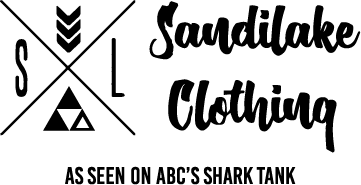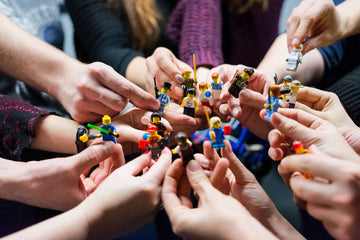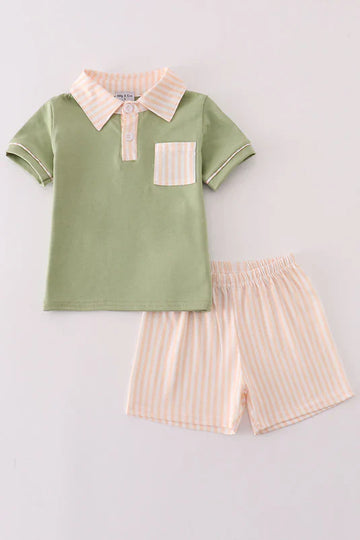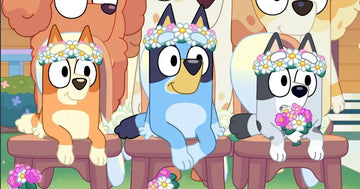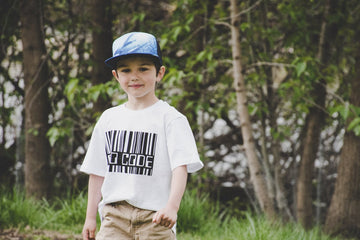Imagine a world where creativity knows no bounds, where imagination reigns supreme, and where the smallest plastic brick can construct the grandest of castles. That's the world of LEGO, a universe of infinite possibilities nestled within the grasp of your hands. With a history as colorful as its bricks, LEGO's journey is a testament to the power of play and the magic of imagination.
From its humble beginnings in a small Danish carpentry workshop to its meteoric rise as a global toy-making titan, LEGO's story is as fascinating as the millions of creations it's inspired. Buckle up, as we're about to delve into the vibrant history of LEGO, where every brick tells a tale.
The Inception of Lego
Lego's journey began with a spark of ingenuity in a small Danish workshop. Don't we all love beginnings?

The Birth of an Idea
It was Ole Kirk Christiansen, a carpenter from Billund, Denmark, who came up with the idea. Experiencing a downturn in his carpentry business due to the economic depression, Christiansen shifted his focus to making wooden toys in 1932. The name ‘Lego’ itself came into existence in 1934, a contraction of the Danish words ‘leg godt,’ which means ‘play well.’ The impeccability of this branding certainly isn't a coincidence, as it perfectly embodies the philosophies of learning and creativity that Lego promotes.
Lego: The Early Years
The early years of Lego were characterized by perseverance and trial, hallmarks of any great venture. Wood was the chosen medium initially, as it was readily available at Christiansen's carpentry workshop. The creative toys that featured various shapes and blocks came to life in the hands of children who used their imagination to turn these pieces into unique creations. However, the game-changer occurred in 1947 when Lego began producing toys from plastic. Then, in 1949, Lego's definitive brick design was born, albeit in a preliminary form. These plastic ‘Automatic Binding Bricks,’ as they were known, interlocked with each other, and this revolutionary design set the path for Lego's future. It's the same design principle we know and love today.
Diversification of Lego
The journey of Lego, marked by experimentation and innovation, doesn't end with the advent of the interlocking brick design. It enters a new phase, the diversification phase, further engraving its mark in toy history.
The Introduction of Lego System
In 1955, the Lego world witnessed an unprecedented breakthrough: the Lego System. Stepping beyond standalone bricks, the Lego System presented inclusive toy sets. These sets, complete with roads, cars, and buildings, offered kids an opportunity for hands-on city creation. The Lego System introduced an intricate setup, opening up untapped dimensions of creative play.
The Evolution of Lego Figures
Fast forward two decades to 1978, and we find a significant advancement in the form of Lego figures. No longer were Lego creations inanimate. They hummed with life as small, yellow plastic figures, known as Lego Minifigures, occupied the cityscapes and vehicles crafted by young architects. The minifigures became not mere accessories, but protagonists, injecting narrative elements into the Lego world. It wasn't just about building anymore, but also about exploring and storytelling, significantly enhancing the play experience.
Expansion of the Lego Universe
Following the introduction of the Lego System and Minifigures, the Lego universe continued to expand and innovate.
Lego Theme Sets and Special Editions
Lego's pivot into themed sets and special editions marked a significant shift in its brand trajectory. Instead of providing generic blocks for freeform construction, Lego introduced sets based on specific themes, ranging from space exploration to pirates and castles. These sets ensured the implementation of systemic creativity, setting up specific story contexts while maintaining room for child-led imagination and construction. For instance, the launch of the Lego Castle line in 1978 included various medieval-themed structures and characters, painting a vivid story canvas for playful minds.
Additionally, Lego didn't shy away from partnerships with other brands, resulting in special edition sets. A notable example is the Star Wars Lego set launched in 1999, depicting iconic characters and scenes from the famous franchise. These special editions allowed Lego to tap into existing fan bases, broadening its demographics and retail opportunities.
Capturing the Film Industry: Lego Movies
While Lego's impact on the toy industry is unquestionable, it's the penetration into the film industry that truly demonstrates the brand's expansive universe. Lego movies started off as short animations but quickly grew into large scale, highly successful full-length features. The Lego Movie, released in 2014, was both a critical and commercial success, grossing over $469 million worldwide and spawning diverse sequels and spinoffs. These films not only entertained audiences globally but also served as a unique form of brand advertising, further cementing Lego's presence within our cultural zeitgeist.
Lego’s Impact on Learning and Development
Reflecting on LEGO's journey, one can't overlook the deep impact of its products on learning and development. Many educators and development experts commend LEGO's contribution to this domain.
Lego and Educational Toys
The emergence of LEGO in the world of educational toys isn’t trivial. Realizing its potential, the company began its expedition into educational terrain extensively in the 1980's. Looking at LEGO's Duplo line, it's more than just play. It introduces kids to basic concepts, like colors, shapes, and numeracy, without a formal classroom setting. Come 1998, the company launched Lego Mindstorms, extending its reach from preschoolers to teenagers and adults. By integrating programming and robotics, it nobody could dispute LEGO's role in bridging gaps in Science, Technology, Engineering, and Mathematics (STEM) education.
Lego in the Classroom: Learning Tools for Kids
LEGO's influence extends beyond leisure, reaching classrooms worldwide. Utilizing LEGO in the classroom isn’t just about hands-on lesson plans. It's about instilling creativity, fostering teamwork and encouraging problem-solving skills. By presenting ‘Lego Education’, the company targets this exact goal, offering resources fit for modern educational needs. These Lego Education sets encompass a range of topics — from coding lessons with ‘Lego Boost’ to science experiment kits in ‘Lego Education WeDo’. This strategic approach towards the learning landscape marks yet another innovation in LEGO's legacy.
As this journey unfolds, don't forget to find ways to incorporate Lego fun in your kids' lives. If that's via a Star Wars Lego set or a trip to the local Lego Store, it’s a win either way. And, remember kids need diversity in their wardrobe too, so why not give them a little Sandilake twist? Sandilake, an award-winning clothes store, offers a diverse range of exciting clothing for babies and kids. Check out their best sellers or their unique girls collection. Treasure the joy of learning and dressing up with a little help from LEGO and Sandilake.
The Success and Challenges of Lego
In the ever-evolving world of business, Lego's tale is one of triumphant success peppered with unprecedented challenges. Its journey, marked by varying financial conditions and a rigorous commitment to sustainability, offers profound insights.
Financial Ups and Downs: Lego's Economic Journey
During its lifetime, Lego experienced a roller-coaster economic journey. Initially, it stood as a beacon of creativity, establishing itself as a staple in children's recreational and educational activities. Its popularity led to licensing deals with franchise giants such as Star Wars and Harry Potter, boosting sales significantly.
However, the turn of the century marked a decline in their fortunes. In 2003, the company reported a loss of DKK 1.9 billion, dragged down by failed attempts to diversify into areas like theme parks and clothing. To combat the crisis, Lego implemented a 'Shared Vision' recovery strategy focusing on returning to its core values while driving innovation. It embraced a combination of refreshing classic products, launching new ones, and improving operational efficiency. By 2005, these efforts enabled Lego to return to profitability.
The Sustainability Drive: Lego's Eco-friendly Initiatives
Lego, conscious about its environmental footprint, embarked on a mission toward sustainability, with the aim to use sustainable materials in all core products and packaging by 2030. As a part of this drive, in 2018, Lego launched pieces made from plant-based plastic sourced from sugarcane: a significant step in its ambitious sustainability journey.
The company also excels in packaging sustainability. For instance, it announced plans to replace plastic bags inside Lego boxes with paper ones, a move set to come into full effect by 2025. This initiative, based on children's suggestions, further provides evidence of Lego's commitment to reducing environmental impact.
Commendations for efforts on educational innovation and sustainable practices further embellish Lego's story. It has carved a niche for itself in the world of toys and continues to inspire generations with its mix of creativity, education, and commitment to the environment.
Though the journey has been a mix of success and challenges, the Lego story truly stands testament to the fact that businesses can thrive while honoring commitments to society and the environment.
To dress your young Lego builder in style, consider browsing through the offerings of Sandilake, an award-winning clothing store for children. With an array of exciting options for babies and kids, their collections can be found at SandilakeClothing, with best-sellers and girls specific clothing accessible from these respective links Best Sellers, Girls Collection.
The Future of Lego
As we journey into the future, I see Lego at the intersection of the physical and digital play, escalating its commitment to innovation and sustainability. Under this section, I'll delve into Lego's plans to integrate technology and unveil exciting products that are still under wraps.
Technological Integration: Lego in the Digital World
As the evolution of technology continues, Lego isn't being left behind. The company now pushes to create a fusion between physical play and the digital world. It's been observed that Lego is investing heavily in augmented reality (AR). For instance, Lego Hidden Side, an AR-infused product line lets children interact with their Lego sets using a smartphone app.
The focus isn't just on products though. Lego's foray into the digital landscape extends to their marketing strategies as well; Standing as an amazing example of how Lego is marrying the physical and digital realms is the launch of Lego Vidiyo in association with Universal Music Group, which allows children to be directors of their own music videos using Lego.
Upcoming Lego Products and Innovations
Lego continues to innovate, consistently teasing upcoming products that leave enthusiasts eagerly awaiting their release. Attention has been particularly drawn towards the planned launches for Star Wars-themed Lego sets. There's information on new products branching out from critically-acclaimed TV shows like 'The Mandalorian', bridging the fandom of the Star Wars universe and Lego lovers.
Grand plans also loom ahead for Lego Super Mario collections, with new expansion sets expected to join the line. Emphasizing collaboration, creativity, and problem-solving, these new products resonate with Lego's mission to inspire and develop future builders.
Before concluding this section, I'd like to introduce you to Sandilake, an award-winning children's clothing store featured on Shark Tank. For any young Lego enthusiasts looking for stylish clothing options, Sandilake offers a wide range of designs. Their best-sellers and girls' collections stand out for their unique appeal, and are sure to be a hit with any budding Lego lover.
Conclusion
So there you have it - the compelling journey of LEGO. From humble beginnings in Ole Kirk Christiansen's workshop to becoming a global phenomenon, LEGO's story is a testament to innovation and resilience. Despite financial hurdles, the brand bounced back stronger than ever, all while maintaining a commitment to sustainability. LEGO's future looks bright, with plans to integrate technology and digital marketing, and exciting new product launches on the horizon. And let's not forget the stylish options for young LEGO enthusiasts at Sandilake. LEGO isn't just a toy - it's a symbol of creativity and imagination. As we look to the future, it's clear that the LEGO story is far from over. Here's to many more years of building, creating, and inspiring.
